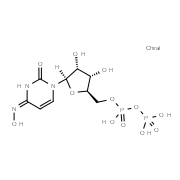NHC-diphosphate
Modify Date: 2024-01-13 18:04:38

NHC-diphosphate structure
|
Common Name | NHC-diphosphate | ||
|---|---|---|---|---|
| CAS Number | 39023-73-9 | Molecular Weight | 419.18 | |
| Density | N/A | Boiling Point | N/A | |
| Molecular Formula | C9H15N3O12P2 | Melting Point | N/A | |
| MSDS | N/A | Flash Point | N/A | |
Use of NHC-diphosphateNHC-diphosphate is an active phosphorylated intracellular metabolite of β-d-N4-Hydroxycytidine (NHC) (HY-125033) as a diphosphate form[1]. NHC is a pyrimidine ribonucleoside and behaves as a potent anti-virus agent. NHC effectively inhibits the replication of venezuelan equine encephalitis virus (VEEV), Chikungunya virus (CHIKV) and hepatitis C virus (HCV)[1]. |
| Name | NHC-diphosphate |
|---|
| Description | NHC-diphosphate is an active phosphorylated intracellular metabolite of β-d-N4-Hydroxycytidine (NHC) (HY-125033) as a diphosphate form[1]. NHC is a pyrimidine ribonucleoside and behaves as a potent anti-virus agent. NHC effectively inhibits the replication of venezuelan equine encephalitis virus (VEEV), Chikungunya virus (CHIKV) and hepatitis C virus (HCV)[1]. |
|---|---|
| Related Catalog | |
| In Vitro | Huh-7 cells are incubated with (10-50 μM; 4 h) NHC or a McGuigan phosphoramidate prodrug of NHC. Intracellular levels of the parental compounds and phosphorylated metabolites are measured using LC-MS/MS. Small amounts of NHC-monophosphate (MP) and NHC-diphosphate (DP; HY-135867D) can be observed, while NHC-triphosphate remains the most abundant metabolite.[1]. |
| References |
| Molecular Formula | C9H15N3O12P2 |
|---|---|
| Molecular Weight | 419.18 |